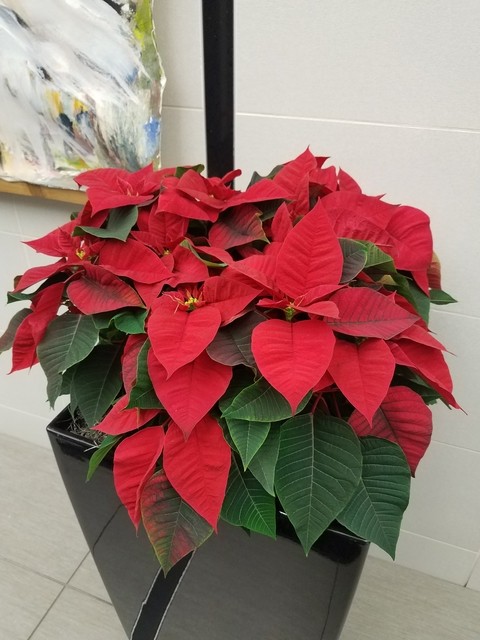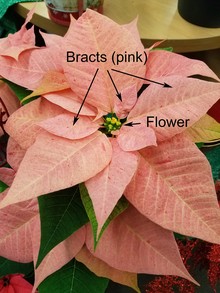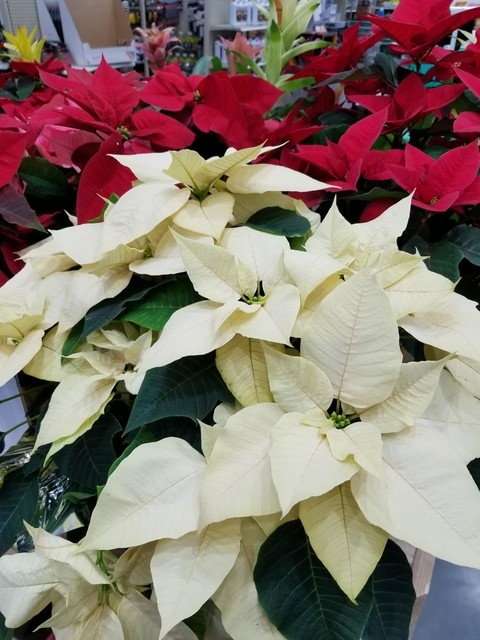Poinsettia care can seem daunting, but with the right knowledge, you can enjoy these beautiful plants year after year. CARS.EDU.VN provides expert advice and guidance to help you master poinsettia maintenance, ensuring they thrive and rebloom. Let’s explore the best practices for poinsettia plant care, including watering, lighting, and seasonal adjustments, and discover how CARS.EDU.VN can further assist you in your gardening journey with our comprehensive guides and resources. Get ready to transform your home with vibrant, healthy poinsettias.
1. Understanding Poinsettias: A Comprehensive Overview
Poinsettias, scientifically known as Euphorbia pulcherrima, are native to Mexico and have become synonymous with holiday cheer due to their vibrant bracts. Understanding their basic biology and needs is the first step in providing excellent care. Let’s explore the key aspects of poinsettias to ensure they thrive in your home.
1.1. The Anatomy of a Poinsettia
It’s a common misconception that the colorful parts of a poinsettia are its flowers. In reality, these vibrant “petals” are modified leaves called bracts. The actual flowers are the small, yellow structures in the center of the bracts, known as cyathia. The bracts change color in response to shorter days, a process called photoperiodism.
1.2. Popular Varieties and Colors
Poinsettias come in a stunning array of colors and forms, including:
- Red: The classic and most popular choice.
- White: Offering a clean, elegant look.
- Pink: Providing a softer, more romantic feel.
- Marbled: Featuring a mix of colors for added visual interest.
- Novelty: Including unique colors like orange, purple (often spray-painted), and patterned bracts.
1.3. Poinsettias and Safety
Despite the long-standing myth, poinsettias are not poisonous. However, their sap can cause mild skin irritation in some individuals. It’s advisable to wear gloves when handling them and to keep them out of reach of pets and small children who might ingest the leaves.
2. Initial Poinsettia Care: From Purchase to Placement
Bringing a poinsettia home involves more than just placing it on a shelf. Proper initial care sets the stage for a healthy, long-lasting plant. Here’s how to ensure your poinsettia gets off to the best start.
2.1. Selecting a Healthy Plant
When choosing a poinsettia, look for these signs of health:
- Vibrant Bracts: The bracts should be richly colored and evenly distributed.
- Healthy Foliage: The green leaves should be a deep, healthy green, free from spots or yellowing.
- Intact Cyathia: The small yellow flowers (cyathia) in the center should be present and not shedding pollen, indicating the plant is fresh.
- Firm Soil: The soil should be moist but not waterlogged.
- No Signs of Pests: Check for any signs of insects, such as whiteflies or aphids.
2.2. Transportation Tips
Protect your poinsettia during transport, especially in cold weather. Wrap it in a protective sleeve or bag to shield it from drafts and temperature fluctuations. Avoid leaving it in a cold car for extended periods.
2.3. Ideal Placement in Your Home
Poinsettias thrive in bright, indirect light. Place them in a south, east, or west-facing window where they can receive ample daylight. Avoid direct sunlight, which can scorch the bracts.
- Temperature: Maintain a consistent indoor temperature between 65 and 70 degrees Fahrenheit (18-21 degrees Celsius).
- Avoid Drafts: Keep poinsettias away from cold drafts, heat vents, and fireplaces, as these can cause stress and leaf drop.
3. Watering Your Poinsettia: Achieving the Right Balance
Proper watering is crucial for poinsettia health. Overwatering and underwatering are common mistakes that can lead to problems. Here’s how to water your poinsettia correctly.
3.1. Determining When to Water
Water your poinsettia when the soil surface feels dry to the touch. You can also lift the pot to gauge its weight; a lightweight pot indicates the soil is dry.
3.2. Watering Technique
- Remove from Decorative Pot: Take the poinsettia out of its decorative foil or outer pot to allow for proper drainage.
- Water Thoroughly: Place the plant in a sink and water thoroughly until water drains from the bottom.
- Allow Drainage: Let the plant drain completely before returning it to its decorative pot.
- Avoid Standing Water: Never allow the pot to sit in standing water, as this can lead to root rot.
3.3. Seasonal Adjustments
- During Blooming: Water regularly to keep the soil consistently moist.
- After Blooming: Reduce watering as the plant enters dormancy.
4. Lighting and Temperature: Essential Environmental Factors
Poinsettias are sensitive to light and temperature. Providing the right conditions is vital for their health and vibrant color.
4.1. Optimal Light Conditions
- Indoor Light: Bright, indirect light from a south, east, or west-facing window is ideal.
- Outdoor Light (Summer): Part sun, 4 to 6 hours daily.
4.2. Maintaining the Right Temperature
- Indoor Temperature: Maintain a consistent temperature between 65 and 70 degrees Fahrenheit (18-21 degrees Celsius).
- Avoid Fluctuations: Protect poinsettias from sudden temperature changes, which can cause stress.
- Minimum Temperature: Poinsettias can suffer damage if exposed to temperatures below 50 degrees Fahrenheit (10 degrees Celsius). Freezing temperatures will kill them.
5. Fertilizing Poinsettias: Providing Essential Nutrients
Fertilizing helps poinsettias thrive, especially during periods of active growth. Here’s how to fertilize your poinsettia effectively.
5.1. When to Fertilize
- During the Holidays: Fertilization is not necessary.
- After the Holidays: Start fertilizing when you see new growth (new green leaves, stems, and bracts).
5.2. Choosing the Right Fertilizer
Use an all-purpose household plant fertilizer. Look for a balanced formula, such as 20-20-20, which provides equal amounts of nitrogen, phosphorus, and potassium.
5.3. Fertilizing Technique
- Dilute the Fertilizer: Mix the fertilizer with water at half the recommended strength to avoid burning the roots.
- Frequency: Feed your poinsettia every 3-4 weeks during the growing season.
6. Pruning and Transplanting: Encouraging Growth and Health
Pruning and transplanting are essential for maintaining a healthy and vibrant poinsettia. These practices help promote new growth and prevent the plant from becoming root-bound.
6.1. Pruning Techniques
- Valentine’s Day: If your plant has become long and leggy, cut it back to about five inches tall to encourage more compact growth.
- St. Patrick’s Day: Prune off faded and dried parts of the plant.
- Memorial Day: Trim off two to three inches of branches to promote side branching.
6.2. Transplanting Guidelines
- Timing: In late spring or early summer, transplant your poinsettia into a larger container or a part-sun garden bed.
- Container Selection: Choose a pot that is 2 to 4 inches larger than the original pot and has good drainage.
- Soil Mix: Use a soil mix with a good amount of organic matter, such as peat moss.
- Garden Planting: In the garden, plant in well-drained soil that gets 4 to 5 hours of sun per day. Mix in organic matter like peat moss or compost.
6.3. Step-by-Step Transplanting Process
- Prepare the New Pot: Fill the new pot with the soil mix, leaving enough space for the root ball.
- Remove the Poinsettia: Gently remove the poinsettia from its original pot, loosening the root ball if necessary.
- Place in New Pot: Center the poinsettia in the new pot and fill in the sides with soil.
- Water Thoroughly: Water the poinsettia thoroughly after transplanting.
7. Pest and Disease Management: Keeping Your Poinsettia Healthy
Poinsettias can be susceptible to certain pests and diseases. Regular inspection and prompt treatment are key to keeping your plant healthy.
7.1. Common Pests
- Whiteflies: These tiny, white, flying insects suck sap from the leaves, causing yellowing and leaf drop.
- Spider Mites: These tiny pests create webs on the plant and cause the leaves to become speckled and yellow.
- Mealybugs: These cottony, white insects cluster on the stems and leaves, sucking sap from the plant.
7.2. Common Diseases
- Root Rot: This fungal disease is caused by overwatering and poor drainage. Symptoms include wilting, yellowing leaves, and a foul odor from the soil.
- Botrytis Blight: This fungal disease causes gray mold on the bracts and leaves, especially in humid conditions.
7.3. Prevention and Treatment
- Regular Inspection: Check your poinsettia regularly for signs of pests or diseases.
- Proper Watering: Avoid overwatering and ensure good drainage to prevent root rot.
- Good Air Circulation: Provide good air circulation to prevent fungal diseases.
- Insecticidal Soap: Use insecticidal soap to treat infestations of whiteflies, spider mites, and mealybugs.
- Fungicides: Apply fungicides to control fungal diseases like root rot and botrytis blight.
8. Encouraging Reblooming: The Secret to Year-Round Color
One of the biggest challenges with poinsettias is getting them to rebloom. This requires careful manipulation of light and temperature.
8.1. The Importance of Short Days
Poinsettias are short-day plants, meaning they need long periods of darkness to initiate bract color change. This process typically begins in the fall.
8.2. Step-by-Step Reblooming Guide
- New Year’s Day: Fertilize if you see new growth. Continue to provide adequate light and water.
- Valentine’s Day: Check for insects and cut back leggy growth.
- St. Patrick’s Day: Prune off faded parts and add fresh potting soil if needed.
- Memorial Day: Trim branches and transplant into a larger container.
- Father’s Day: Move the plant outside to a location with indirect light.
- Fourth of July: Trim the plant again and move it into full sun. Increase watering and fertilizing.
- Labor Day: Move the plant indoors to a spot that gets at least six hours of direct light daily. Reduce fertilizer to one-quarter the recommended strength.
- Fall Equinox (Around September 21): Give the plant 16 hours of uninterrupted darkness (put it in a closet, basement, or under a box) and 8 hours of bright light every day. Maintain night temperatures in the low 60s Fahrenheit (15-18 degrees Celsius).
- Thanksgiving: Discontinue the short day/long night treatment. Put the plant in a sunny area that gets at least six hours of direct light. Reduce water and fertilizer.
- Christmas: Enjoy your “new” poinsettia and start the cycle again after the new year.
8.3. Troubleshooting Common Issues
- Leaf Drop: This can be caused by temperature fluctuations, overwatering, underwatering, or drafts.
- Lack of Color Change: Ensure the plant receives complete darkness during the short day treatment.
- Pest Infestations: Regularly inspect the plant and treat any infestations promptly.
9. Creative Uses for Poinsettias: Beyond Holiday Decor
Poinsettias are versatile plants that can be used in a variety of creative ways beyond traditional holiday decorations.
9.1. Poinsettias in Floral Arrangements
Cut poinsettia bracts can be used in floral arrangements. To prevent wilting, sear the cut ends with a flame or dip them in boiling water for a few seconds.
9.2. Poinsettias in Container Gardens
Poinsettias can be combined with other plants in container gardens. Choose plants with similar light and water requirements to create a harmonious display.
9.3. Poinsettias as Gifts
A well-cared-for poinsettia makes a thoughtful and festive gift. Consider gifting a poinsettia in a unique pot or container to add a personal touch.
10. Poinsettia FAQs: Addressing Common Questions
Here are some frequently asked questions about poinsettia care:
- Are poinsettias poisonous to pets?
- No, poinsettias are not highly toxic to pets, but their sap can cause mild irritation if ingested.
- Why are my poinsettia leaves turning yellow?
- Yellow leaves can be caused by overwatering, underwatering, temperature fluctuations, or pest infestations.
- How often should I water my poinsettia?
- Water when the soil surface feels dry to the touch, typically every 1-2 weeks.
- What kind of light does a poinsettia need?
- Poinsettias need bright, indirect light from a south, east, or west-facing window.
- How can I get my poinsettia to rebloom?
- Provide 16 hours of complete darkness and 8 hours of bright light daily for about 8 weeks in the fall.
- Why are my poinsettia bracts falling off?
- Bract drop can be caused by temperature fluctuations, drafts, or improper watering.
- Do poinsettias need fertilizer?
- Fertilize during the growing season (after the holidays) with a balanced, all-purpose fertilizer.
- Can I plant my poinsettia outside?
- Yes, you can plant your poinsettia outside in the summer in a location with part sun.
- What is the ideal temperature for a poinsettia?
- Maintain a consistent temperature between 65 and 70 degrees Fahrenheit (18-21 degrees Celsius).
- How do I get rid of pests on my poinsettia?
- Use insecticidal soap to treat infestations of whiteflies, spider mites, and mealybugs.
11. Advanced Poinsettia Care: Tips for the Experienced Gardener
For those looking to take their poinsettia care to the next level, here are some advanced tips:
- Humidity Control: Poinsettias prefer moderate humidity. Increase humidity by placing the plant on a pebble tray filled with water or using a humidifier.
- Air Circulation: Ensure good air circulation around the plant to prevent fungal diseases.
- Soil Testing: Periodically test the soil to ensure it has the right pH and nutrient levels.
- Root Pruning: When transplanting, consider root pruning to encourage new growth.
- Grafting: Experienced gardeners can try grafting different poinsettia varieties to create unique plants with multiple colors.
12. CARS.EDU.VN: Your Partner in Poinsettia Care
At CARS.EDU.VN, we understand the challenges of maintaining healthy and vibrant poinsettias. That’s why we offer a wealth of resources to help you succeed.
12.1. Comprehensive Guides and Articles
Our website features detailed guides and articles on all aspects of poinsettia care, from selecting the right plant to encouraging reblooming. We provide step-by-step instructions and expert advice to help you master poinsettia maintenance.
12.2. Expert Advice and Support
Our team of horticultural experts is available to answer your questions and provide personalized advice. Whether you’re struggling with a specific issue or simply looking for tips on how to improve your poinsettia care routine, we’re here to help.
12.3. Community Forum
Join our community forum to connect with other poinsettia enthusiasts. Share your experiences, ask questions, and learn from fellow gardeners.
12.4. Local Resources and Services
We can also help you find local resources and services, such as nurseries, garden centers, and landscaping professionals, to support your poinsettia care efforts.
12.5. Stay Updated with the Latest Trends
Keep up with the latest trends and innovations in poinsettia care. CARS.EDU.VN provides regular updates on new varieties, techniques, and products to help you stay ahead of the curve.
13. Seasonal Care Calendar: A Year-Round Guide
To ensure your poinsettia thrives throughout the year, follow this seasonal care calendar:
| Season | Month | Care Tasks |
|---|---|---|
| Winter | December | Enjoy the blooming poinsettia. Water when the soil surface feels dry. |
| January | Fertilize if you see new growth. Continue to provide adequate light and water. | |
| Spring | February | Check for insects and cut back leggy growth. |
| March | Prune off faded parts and add fresh potting soil if needed. | |
| April | Continue providing bright, indirect light and moderate watering. | |
| May | Trim branches and transplant into a larger container. | |
| Summer | June | Move the plant outside to a location with indirect light. |
| July | Trim the plant again and move it into full sun. Increase watering and fertilizing. | |
| August | Continue watering and fertilizing, monitoring for pests and diseases. | |
| Fall | September | Move the plant indoors to a spot that gets at least six hours of direct light daily. Reduce fertilizer. |
| October | Begin short day/long night treatment (16 hours darkness, 8 hours light). | |
| November | Continue short day/long night treatment. Reduce water and fertilizer. |



14. Case Studies: Successful Poinsettia Care Stories
Learn from real-life examples of successful poinsettia care:
14.1. The Reblooming Success Story
Sarah, a homeowner in California, struggled to get her poinsettia to rebloom for years. After following the reblooming guide on CARS.EDU.VN, she was thrilled to see her poinsettia’s bracts turn a vibrant red just in time for Christmas.
14.2. Overcoming Pest Infestations
Mark, a gardener in Florida, battled a severe whitefly infestation on his poinsettia. With the help of our expert advice and recommended treatments, he was able to eliminate the pests and restore his plant to health.
14.3. Reviving a Neglected Poinsettia
Emily, a student in New York, inherited a neglected poinsettia from a friend. Following our guidance on reviving stressed plants, she was able to bring the poinsettia back to life and enjoy its beauty.
15. Resources for Further Learning
- University Extension Offices: Contact your local university extension office for regional-specific advice and resources.
- Botanical Gardens: Visit local botanical gardens to see poinsettias in different settings and learn from experts.
- Online Forums: Participate in online gardening forums to connect with other poinsettia enthusiasts and share your experiences.
- Gardening Books: Consult gardening books for in-depth information on poinsettia care and related topics.
16. Conclusion: Enjoying Your Poinsettia Year-Round
With the right knowledge and care, you can enjoy the beauty of poinsettias throughout the year. From selecting a healthy plant to encouraging reblooming, following these guidelines will help you succeed. At CARS.EDU.VN, we’re committed to providing you with the resources and support you need to master poinsettia care.
17. Contact CARS.EDU.VN for Expert Assistance
Do you have questions about poinsettia care? Need personalized advice or support? Contact us today!
- Address: 456 Auto Drive, Anytown, CA 90210, United States
- WhatsApp: +1 555-123-4567
- Website: CARS.EDU.VN
We’re here to help you create a vibrant and beautiful home with healthy, thriving poinsettias.
Are you struggling to keep your poinsettias vibrant and healthy, or looking for reliable services to ensure their long-lasting beauty? Visit cars.edu.vn today for expert guidance, comprehensive resources, and personalized support to master poinsettia care and transform your home into a haven of floral splendor.
